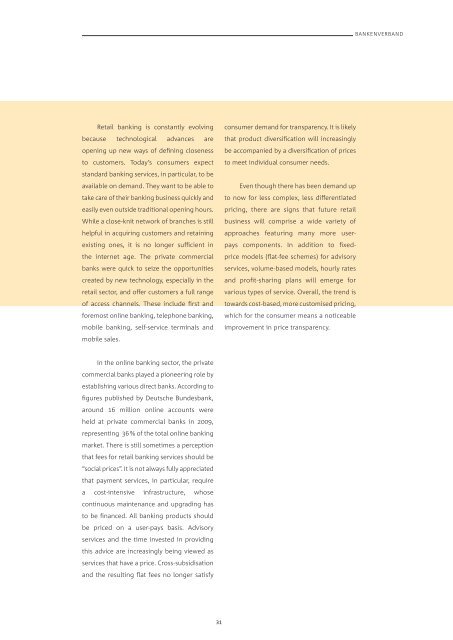Banks and Consumers
The Comprehensive Consumer Policy Scheme of the German Private Commercial Banks
The Comprehensive Consumer Policy Scheme of the German Private Commercial Banks
You also want an ePaper? Increase the reach of your titles
YUMPU automatically turns print PDFs into web optimized ePapers that Google loves.
BANKENVERBAND<br />
Retail banking is constantly evolving<br />
because technological advances are<br />
opening up new ways of defining closeness<br />
to customers. Today’s consumers expect<br />
st<strong>and</strong>ard banking services, in particular, to be<br />
available on dem<strong>and</strong>. They want to be able to<br />
take care of their banking business quickly <strong>and</strong><br />
easily even outside traditional opening hours.<br />
While a close-knit network of branches is still<br />
helpful in acquiring customers <strong>and</strong> retaining<br />
existing ones, it is no longer sufficient in<br />
the internet age. The private commercial<br />
banks were quick to seize the opportunities<br />
created by new technology, especially in the<br />
retail sector, <strong>and</strong> offer customers a full range<br />
of access channels. These include first <strong>and</strong><br />
foremost online banking, telephone banking,<br />
mobile banking, self-service terminals <strong>and</strong><br />
mobile sales.<br />
consumer dem<strong>and</strong> for transparency. It is likely<br />
that product diversification will increasingly<br />
be accompanied by a diversification of prices<br />
to meet individual consumer needs.<br />
Even though there has been dem<strong>and</strong> up<br />
to now for less complex, less differentiated<br />
pricing, there are signs that future retail<br />
business will comprise a wide variety of<br />
approaches featuring many more userpays<br />
components. In addition to fixedprice<br />
models (flat-fee schemes) for advisory<br />
services, volume-based models, hourly rates<br />
<strong>and</strong> profit-sharing plans will emerge for<br />
various types of service. Overall, the trend is<br />
towards cost-based, more customised pricing,<br />
which for the consumer means a noticeable<br />
improvement in price transparency.<br />
In the online banking sector, the private<br />
commercial banks played a pioneering role by<br />
establishing various direct banks. According to<br />
figures published by Deutsche Bundesbank,<br />
around 16 million online accounts were<br />
held at private commercial banks in 2009,<br />
representing 36 % of the total online banking<br />
market. There is still sometimes a perception<br />
that fees for retail banking services should be<br />
“social prices”. It is not always fully appreciated<br />
that payment services, in particular, require<br />
a cost-intensive infrastructure, whose<br />
continuous maintenance <strong>and</strong> upgrading has<br />
to be financed. All banking products should<br />
be priced on a user-pays basis. Advisory<br />
services <strong>and</strong> the time invested in providing<br />
this advice are increasingly being viewed as<br />
services that have a price. Cross-subsidisation<br />
<strong>and</strong> the resulting flat fees no longer satisfy<br />
31


















